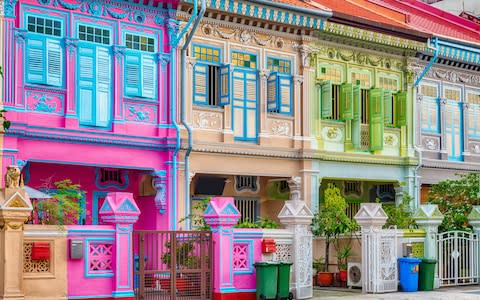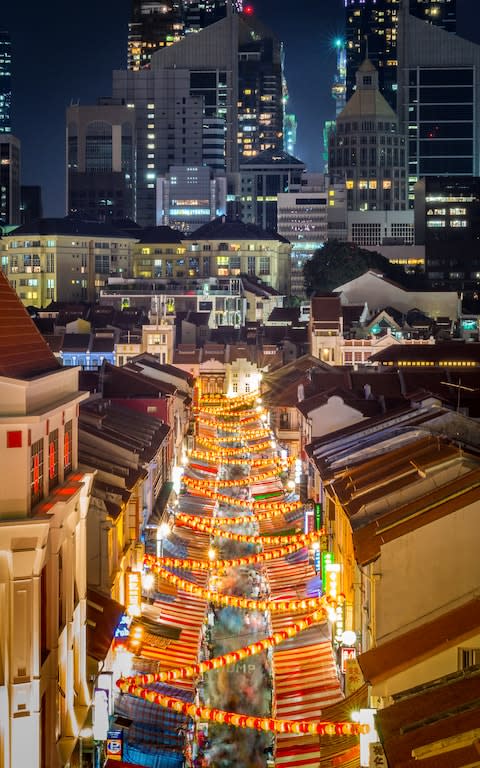Crazy, rich city: what to do if you're a super-wealthy visitor to Singapore

When I was growing up in Singapore in the late ’60s, foreigners never mentioned the city. I’ve seen it transition, in ways my parents’ generation could never have imagined. Now it has taken its place in the global community. This year marks 200 years since Sir Stamford Raffles founded Singapore and it’s just 54 years since the city-state achieved independence.
In that time, the world has changed and we’ve changed too. We’re multiracial – I’m part-Cantonese, part Peranakan, which means Straits-born Chinese – and there are sizeable Malay, Chinese, Indian and Eurasian communities. You get a sense of these influences when you eat out.
We might have Malay coconut rice for breakfast, Cantonese noodles for lunch and then biryani for dinner. Food is the fabric of our society. The British might go to a pub for drinks; we just eat.

Visitors can get a sense of that at Singapore’s hawker centres, compounds with various food stalls. You go from one to the other and bring your dishes – maybe mutton with a sweet marinade or barbecued stingray – to one of the central tables. You can get a meal for £3, but when it comes to food there are no class barriers here – you see princes and prime ministers eating in these places.
That said, there’s a very wealthy community in Singapore and the film Crazy Rich Asians, which is set here, shows that. I work as a celebrity photographer and played myself in the movie. When the producers visited for the first time a few years ago, I showed them around, as I wanted to make sure their impressions were as accurate as could be.
I grew up around the types of people depicted in the film: what you see on screen is inspired by real people and real families here; it isn’t a fantasy. But it’s just one facet to Singapore, and this is a place that caters to everyone.

We’re not as congested as you might think – there’s greenery everywhere and a nature reserve where you can walk and hike. The Singapore Botanic Gardens are our Hyde Park, an oasis in the city with old trees and orchids. They do good open-air shows; you might arrive to a classical concert or jazz performance.
People from Tokyo and Hong Kong come to Singapore and feel they’ve got a bit more air to breathe. I’ve had people tell me they feel like they’re in Hawaii or Miami.
I also like the old Peranakan shophouses around the upmarket Emerald Hill neighbourhood. They’re colourful buildings with wooden shutters, with Portuguese and Dutch influences, and might house cafés, bars or shops. It gives visitors a sense of what pre-war Singapore was like, and I recommend visiting the Peranakan Museum to understand our history of immigration.

The vibe is different in Little India. It has been there for ages and is a very organic and lively neighbourhood. Walking through, you smell spices and incense, hear Indian music, see dazzling colours and taste phenomenal food. It’s sensory overload.
And everywhere you should notice an emerging sense of creativity. We’re such a young country and, since gaining independence in 1965, we’ve been searching for an identity, a voice, trying to make sense of who we are. Now younger people, especially, are becoming more daring and expressive and we can see those shifts in music, theatre and art. We’re finding our voice and continuing to evolve. Things are looking good for Singapore.
Russel Wong is one of the most prolific fashion and portrait photographers in Singapore and Asia; russelwongphoto.com
The luxury travel guide to the best of Singapore, by Evelyn Chen
The hotels
Singapore’s iconic hotel, Raffles is currently closed for restoration – although it is due to reopen later this year.
Meanwhile, after a period of restoration and renovation, including a three-year delay due to a dispute between the owners, the Capitol Building and Stamford House in the civic district have just reopened as an ultra-luxe hotel. Now rebranded the Capitol Kempinski Hotel Singapore, the 157 rooms and suites are smart and elegantly appointed, with dark wood and muted tones. Book the 1,475-sq ft Heritage Suite to pamper yourself. Suites from S$1,050 (£690); other rooms from S$568 (£390).

On the banks of the Singapore River,the Warehouse Hotel at Robertson Quay offers a similarly luxurious experience. Built in 1895, the building once saw life as a godown (or warehouse), a disco and an oil mill before it was restored to its current sleek self. There are only 37 rooms, each with a different layout but uniformly bathed in taupe and muted grey. For the complete experience, dine at Po restaurant and finish with a cocktail in the Lobby Bar. Suites from S$485 (minimum two nights); rooms from S$243.
The lunch stop
Reservations at Candlenut, the only one-Michelin-starred Straits-Chinese restaurant in the world, are understandably difficult to come by. With advance planning, however, you’ll get to savour chef Malcolm Lee’s heartwarming creations such as bakwan kepiting, chicken broth flecked with crab-chicken balls and bamboo shoots. Peranakan food newbies are advised to order the chef-directed ‘Ah-ma-kase’ menu. Ahmakase lunch for one without wine, S$88.

Perched on the 70th floor of Swiss?tel the Stamford, the one-Michelin-starred Jaan offers chef Kirk Westaway’s contemporary take on British cuisine, complete with white-glove service and an unsurpassed view of the city. His signature, the ‘English Garden’, is an array of artfully arranged seasonal vegetables with puddles of sauces served with a watering can of Scottish seaweed herbed dressing. Four-course lunch for one from S$98 per head.
The dinner venue
Odette by French chef-owner Julien Royer is Singapore’s highest-rated restaurant on the Asia’s 50 Best Restaurants list. Its eight-course menu is an unfussy curation of the season’s best European and Japanese ingredients prepped with superb French techniques. A highlight is his pigeon ‘beak to tail’ dish – Kampot pepper-flecked pigeon’s breast with crispy leg, liver parfait and skewered hearts. Dinner for one without wine, S$328.
At the Singapore Botanic Gardens, the city’s only Unesco World Heritage Site, Corner House serves ‘Gastro-Botanica’ cuisine by French-trained local chef, Jason Tan. Taking centre stage is Tan’s interpretation of Cevennes onion served four ways, a course headlined by a baked onion cup filled with sweet-onion purée and a disc of slow-cooked egg topped with chives and black-truffle shavings. Dinner for one without wine, S$208.

One of the city’s most impressive new openings is Preludio, with its accomplished cooking using highly seasonal ingredients presented in a themed ‘chapter’ – at the moment, black-and-white dishes. Unlike most upscale restaurants, Colombian chef-owner Fernando Arevalo, an alum of Daniel Boulud in New York, eschews the route of a bite-sized-snacks parade, preferring to field a singular amuse bouche, then building substance as the meal progresses. His jet-black ‘pata negra’ and white-as-snow ‘Gorbea mountain’ dessert alone are worth a reservation at dinner. Dinner for one without wine, S$168.
The opening of Restaurant Zén brings chef-owner Bj?rn Frantzén’s brand of highbrow ‘Nordickaiseki with French perfume’, and with it astronomical prices,to tropical Singapore. Your ritualistic tasting menu starts with snacks in The Kitchen on the ground floor, builds up to an eight-course tasting menu in The Dining Room on level two and ends with a spread of sweets in the The Living Room on the third floor. Fans of Stockholm’s Frantzén will rejoice at the prospect of reuniting with the ‘French toast’ with Parmesan custard and white-truffle shavings. Dinner for one without wine, S$450.

The bars & cafés
Cocktail bars are a dime a dozen in Singapore, but Operation Dagger is a ‘secret’ subterranean venue with a speakeasy feel. Accessed via a back alley and decorated with hundreds of cloud-like light bulbs, this underground bar by owner-bartender Luke Whearty serves experimental cocktails best savoured via the omakase cocktail and food pairings menu. Try the home-fermented fruit wines if you’re here for a pre-dinner drink. Omakase from S$95.
The place to be seen
Catering to the city’s most prolific wine and whisky connoisseurs, La Terre is an austere 15-seat bar with a 500 label-strong list of mostly old world wines and a stash of 150 varieties of whisky – think various vintages of Domaine de la Romanée-Conti wine and the ultrarare, 48-year-old Karuizawa whisky.

The places to see
Occupying the space of the City Hall and the former Supreme Court, the National Gallery boasts 8,000 pieces from Singapore’s National Collection and currently houses the largest public collection of modern art in Singapore and Southeast Asia. Odette (see above) is also in the same building. Once you’ve tried Straits-Chinese cuisine, you’ll be intrigued to learn more about the Peranakan history, tradition and lifestyle.
The Intan is collector Alvin Yapp’s private collection of Peranakan trinkets and artefacts, housed in his shop/house. Book the one-hour The Intan Tea Tour (minimum four people).

The places to shop
Home to 14 duplex and triplex stores and some of the world’s most luxurious brands including Ralph Lauren, Hermès, Chanel, Cartier and Louis Vuitton, The Shoppes at Marina Bay Sands stock some of the most exclusive pieces money can buy. To start, how about a personalised scent (costing upwards of S$45,000) from boutique perfumer Henry Jacques?
Created by a French couple, Akar de Nissim sells furniture and homeware – including lighting and home fragrance – with clean lines and Asian detailing. Pieces are made in its Vietnam-based workshop by a French craftsman.
Getting there
Singapore Airlines flies direct from Heathrow to Singapore, from £515 economy return, £3,030 business class. For more information see visitsingapore.com.
Sign up for the Telegraph Luxury newsletter for your weekly dose of exquisite taste and expert opinion.
